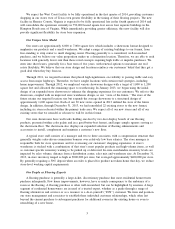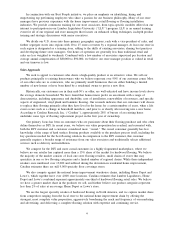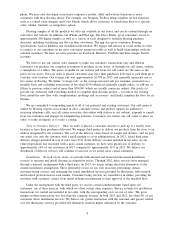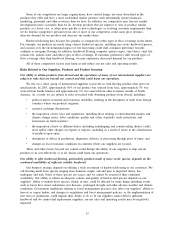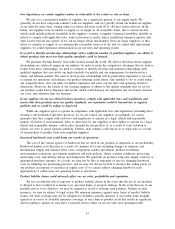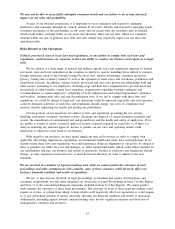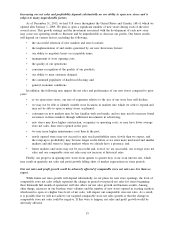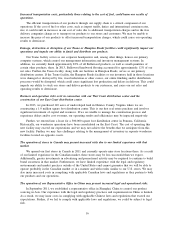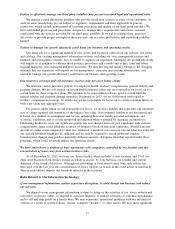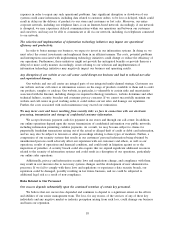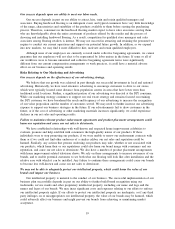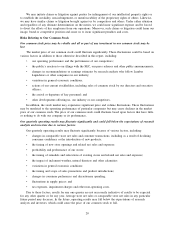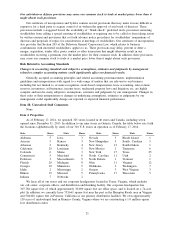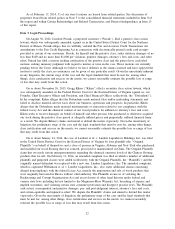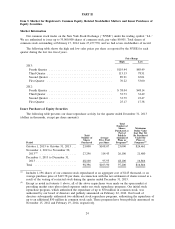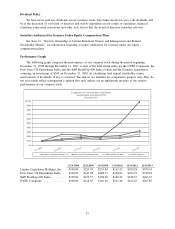Lumber Liquidators 2013 Annual Report Download - page 25
Download and view the complete annual report
Please find page 25 of the 2013 Lumber Liquidators annual report below. You can navigate through the pages in the report by either clicking on the pages listed below, or by using the keyword search tool below to find specific information within the annual report.Increasing our net sales and profitability depends substantially on our ability to open new stores and is
subject to many unpredictable factors.
As of December 31, 2013, we had 318 stores throughout the United States and Canada, 168 of which we
opened after January 1, 2009. We plan to open a significant number of new stores during each of the next
several years. This growth strategy and the investment associated with the development of each new store
may cause our operating results to fluctuate and be unpredictable or decrease our profits. Our future results
will depend on various factors, including the following:
• the successful selection of new markets and store locations;
• the implementation of and results generated by our new showroom format;
• our ability to negotiate leases on acceptable terms;
• management of store opening costs;
• the quality of our operations;
• consumer recognition of the quality of our products;
• our ability to meet customer demand;
• the continued popularity of hardwood flooring; and
• general economic conditions.
In addition, the following may impact the net sales and performance of our new stores compared to prior
years:
• as we open more stores, our rate of expansion relative to the size of our store base will decline;
• we may not be able to identify suitable store locations in markets into which we seek to expand and
may not be able to open as many stores as planned;
• consumers in new markets may be less familiar with our brands, and we may need to increase brand
awareness in those markets through additional investments in advertising;
• new stores may have higher construction, occupancy or operating costs, or may have lower average
store net sales, than stores opened in the past;
• we may incur higher maintenance costs than in the past;
• newly opened stores may not succeed or may reach profitability more slowly than we expect, and
the ramp-up to profitability may become longer in the future as we enter more mid-sized and smaller
markets and add stores to larger markets where we already have a presence; and
• future markets and stores may not be successful and, even if we are successful, our average store net
sales and our comparable store net sales may not increase at historical rates.
Finally, our progress in opening new stores from quarter to quarter may occur at an uneven rate, which
may result in quarterly net sales and profit growth falling short of market expectations in some periods.
Our net sales and profit growth could be adversely affected if comparable store net sales are less than we
expect.
While future net sales growth will depend substantially on our plans for new store openings, the level of
comparable store net sales (which represent the change in period-over-period net sales for stores beginning
their thirteenth full month of operation) will also affect our net sales growth and business results. Among
other things, increases in our baseline store volumes and the number of new stores opened in existing markets,
which tend to open at a higher base level of net sales, will impact our comparable store net sales. As a result,
it is possible that we will not achieve our targeted comparable store net sales growth or that the change in
comparable store net sales could be negative. If this were to happen, net sales and profit growth would be
adversely affected.
15


